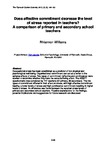Does affective commitment decrease the level of stress reported in teachers? A comparison of primary and secondary school teachers
| dc.contributor.author | Williams, R. | |
| dc.date.accessioned | 2019-05-13T15:57:49Z | |
| dc.date.available | 2019-05-13T15:57:49Z | |
| dc.date.issued | 2010 | |
| dc.identifier.citation |
Williams, R. (2010) 'Does affective commitment decrease the level of stress reported in teachers? A comparison of primary and secondary school teachers', The Plymouth Student Scientist, p. 142-163. | en_US |
| dc.identifier.issn | 1754-2383 | |
| dc.identifier.uri | http://hdl.handle.net/10026.1/13916 | |
| dc.description.abstract |
Occupational stress has been established as a predictor of low physical and psychological well-being. Organisational commitment can act as a buffer to the adverse effects of stress. Two types of commitment (affective and continuance) were studied to determine whether they have the same buffering effect. The ASSET questionnaire was completed by 112 teachers (52 primary, 60 secondary). The two types of commitment differed in their effect on stress, with high affective commitment leading to lower levels of stress and high continuance commitment resulting in higher levels of stress. No difference was found between the reported stress levels of primary and secondary school teachers. Possible explanations for the findings, potential implications and suggestions for future research are discussed. | en_US |
| dc.language.iso | en | en_US |
| dc.publisher | University of Plymouth | |
| dc.rights | Attribution 3.0 United States | * |
| dc.rights.uri | http://creativecommons.org/licenses/by/3.0/us/ | * |
| dc.subject | Occupational stress | en_US |
| dc.subject | stress | en_US |
| dc.subject | psychological well-being | en_US |
| dc.subject | teachers | en_US |
| dc.subject | primary school | en_US |
| dc.subject | secondary school | en_US |
| dc.title | Does affective commitment decrease the level of stress reported in teachers? A comparison of primary and secondary school teachers | en_US |
| dc.type | Article | |
| plymouth.issue | 2 | |
| plymouth.volume | 3 | |
| plymouth.journal | The Plymouth Student Scientist |



